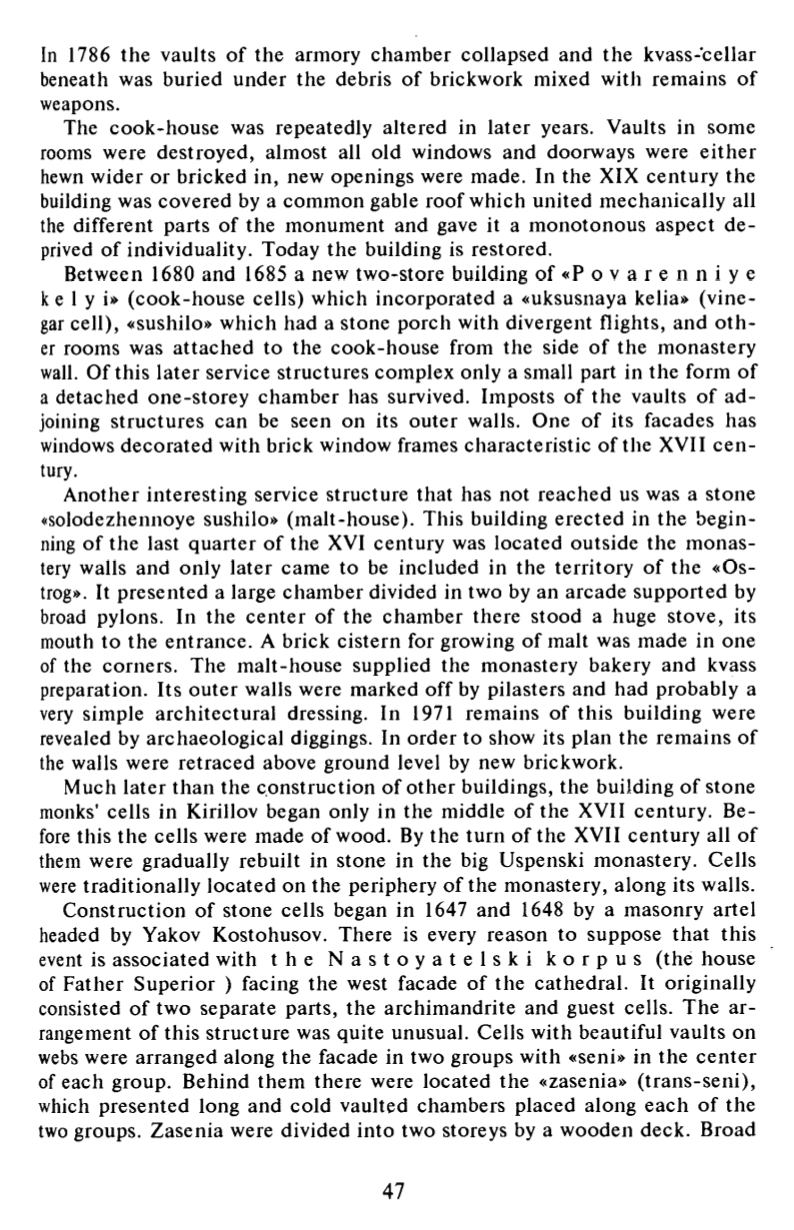

In 1786 the vaults o f the armory chamber collapsed and the kvass-cellar
beneath was buried under the debris o f brickwork mixed with remains o f
weapons.
The cook-house was repeatedly altered in later years. Vaults in some
rooms were destroyed, almost all old windows and doorways were eithe r
hewn wider or bricked in, new openings were made. In the XIX cen tury the
building was covered by a common gable roof which united mechanically all
the different parts of the monument and gave it a mono tonous aspect d e
prived of individuality. Today the building is restored.
Between 1680 and 1685 a new two-store building o f «Р о v a r e n n i у e
к e 1 у i» (cook-house cells) which incorporated a «uksusnaya kelia» (vine
gar cell), «sushilo» which had a stone porch with divergent flights, and o t h
er rooms was a ttached to the cook-house from the side o f the monastery
wall. Of this later service structures complex only a small part in the form of
a detached one-storey chamber has survived. Imposts of the vaults o f a d
joining structures can be seen on its outer walls. One of its facades has
windows decorated with brick window frames characteristic of the XVII c e n
tury.
Another interesting service structure that has not reached us was a stone
«solodezhennoye sushilo» (malt-house). This building erected in the begin
ning o f the last quarter o f the XVI century was located outside the monas
tery walls and only later came to be included in the territory o f the «Os-
trog». It presented a large chamber divided in two by an arcade supported by
broad pylons. In the cen te r of the chamber there stood a huge stove, its
mouth to the entrance. A brick cistern for growing of malt was made in one
of the corners. The malt-house supplied the monastery bakery and kvass
preparation. Its outer walls were marked off by pilasters and had probably a
very simple architectural dressing. In 1971 remains of this building were
revealed by archaeological diggings. In order to show its plan the remains of
the walls were retraced above ground level by new brickwork.
Much later than the construction of other buildings, the building o f stone
monks' cells in Kirillov began only in the middle of the XVII century. Be
fore this the cells were made of wood. By the turn of the XVII century all of
them were gradually rebuilt in stone in the big Uspenski monastery. Cells
were traditionally located on the periphery o f the monastery, along its walls.
Construction of stone cells began in 1647 and 1648 by a masonry artel
headed by Yakov Kostohusov. There is every reason to suppose that this
event is associated with t h e N a s t o y a t e l s k i k o r p u s (the house
of Father Superior ) facing the west facade of the cathedral. It originally
consisted o f two separate parts, the archimandrite and guest cells. The a r
rangement of this structure was quite unusual. Cells with beautiful vaults on
webs were arranged along the facade in two groups with «seni» in the cen te r
of each group. Behind them there were located the «zasenia» (trans-seni),
which presented long and cold vaulted chambers placed along each o f the
two groups. Zasenia were divided into two storeys by a wooden deck. Broad
47















